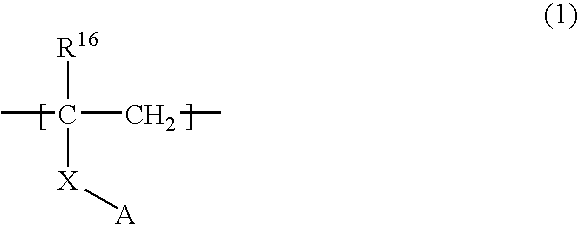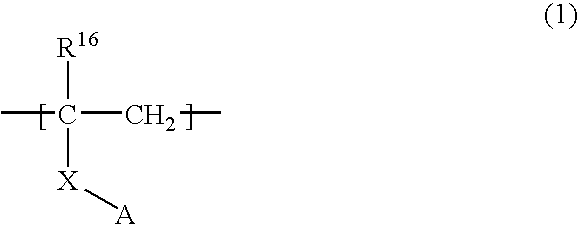Boron-containing polymer compound and organic light emitting device using the same
a light-emitting device and boron-containing polymer technology, applied in the organic semiconductor device, discharge tube/lamp details, natural mineral layered products, etc., can solve the problems that light-emitting materials and organic light-emitting devices using the same cannot achieve a sufficiently high luminous efficiency at a low voltage, and achieve high driving voltage, high luminous efficiency, and increase the effect of emission area
- Summary
- Abstract
- Description
- Claims
- Application Information
AI Technical Summary
Benefits of technology
Problems solved by technology
Method used
Image
Examples
example 1
Synthesis of Polymerizable Compound (Boron Monomer Compound 1)
[0095]
(1) Preparation of Grignard Reagent
[0096]
[0097] Under a nitrogen atmosphere, to a 100 ml-volume four-neck flask, 1.00 g of magnesium, 5 ml of dry tetrahydrofuran (THF) and 2 mg of iodine were charged and stirred at room temperature until there is no iodic color. Thereto was added a solution prepared by dissolving 7.30 g of 4-bromostyrene in 30 ml of dry tetrahydrofuran (THF) dropwise to be a reaction temperature of 15 to 20° C. in a dry-ice / methanol bath. After dropping, the reaction solution was stirred for 60 minutes while keeping the temperature of 15 to 20° C. to prepare a Grignard reagent (StyMgBr).
(2) Synthesis of Triarylboron
[0098]
[0099] under a nitrogen atmosphere, to a 200 ml-volume four-neck flask, 4.16 g of dimesitylboronfluoride and 10 ml of toluene (Tol) were charged. Thereto was added the Grignard reagent (StyMgBr) prepared above to be a temperature of 15 to 20° C., and then stirred for 6 hours whi...
example 2
Synthesis of Polymerizable Compound (Boron Monomer Compound 2)
[0102]
(1) Synthesis of 1-bromo-2,6-dimethyl-4-tert-buthyldimethylsiloxybenzene (Compound 3)
[0103]
[0104] Under a nitrogen atmosphere, to a 100 ml-volume three-neck flask, 5.00 g of 4-bromo-3,5-dimethylphenol, 3.87 g of tert-buthyl dimethylchlorosilane, 10 ml of dry dichloromethane (DCM) and 3 ml of dry dimethylformamide (DMF) were charged and stirred. While stirring, thereto was added a solution prepared by dissolving 1.75 g of imidazole in 10 ml of dry DCM dropwise. After dropping, the reaction solution was stirred for 3 hours at room temperature. Then, the generated impurities were separated by filtration and the filtrate was concentrated under a reduced pressure, and ethyl acetate and 5% aqueous sodium hydrogencarbonate solution were added thereto. The organic layer was separated and washed with water and saturated saline and dried over anhydrous sodium sulfate. After the drying agent was filtered out and the solvent ...
example 3
Synthesis of Polymerizable Compound (Boron Monomer Compound 7)
[0117]
(1) Synthesis of dimesityl(4-styryl-2,6-dimethylphenyl)borane (Compound 7)
[0118]
[0119] To a 100 ml-volume eggplant type flask, 2.22 g of Compound 6 and 12 ml of dry dioxane, 1.66 g of tributyl vinyl tin, 0.64 g of anhydrous lithium chloride, 0.11 g of tetrakis(triphenylphosphine)palladium and 0.03 g of 2,6-di-tert-butyl-4-methyl-phenol were charged and stirred for 3 hours at hot water temperature of 100° C. After standing to cool, thereto was added 2.7 ml of pyridine and 3.2 ml of 1.4M pyridinium fluoride tetrahydrofuran (THF) solution and stirred overnight at room temperature. After that, 10 ml of ethyl acetate was added to the reaction solution and the insoluble matters were separated by filtration. The filtrate was washed with water, 4N hydrochloric acid, water, 4N sodium hydroxide, water and saturated saline in this order and dried over anhydrous sodium sulfate. After the drying agent was filtered out and the ...
PUM
| Property | Measurement | Unit |
|---|---|---|
| atomic numbers | aaaaa | aaaaa |
| atomic numbers | aaaaa | aaaaa |
| external quantum efficiency | aaaaa | aaaaa |
Abstract
Description
Claims
Application Information
 Login to View More
Login to View More - R&D
- Intellectual Property
- Life Sciences
- Materials
- Tech Scout
- Unparalleled Data Quality
- Higher Quality Content
- 60% Fewer Hallucinations
Browse by: Latest US Patents, China's latest patents, Technical Efficacy Thesaurus, Application Domain, Technology Topic, Popular Technical Reports.
© 2025 PatSnap. All rights reserved.Legal|Privacy policy|Modern Slavery Act Transparency Statement|Sitemap|About US| Contact US: help@patsnap.com



